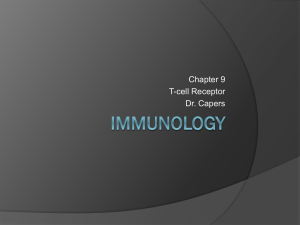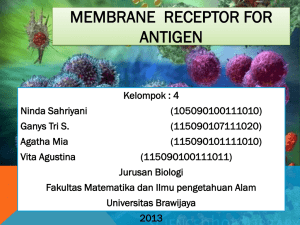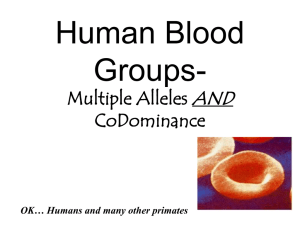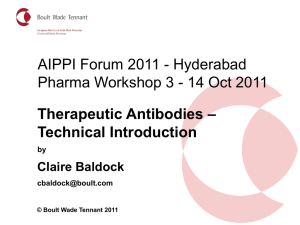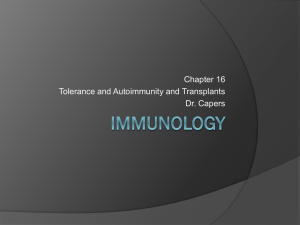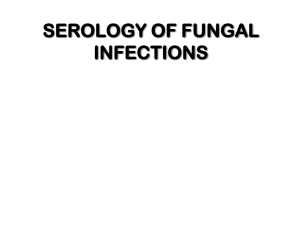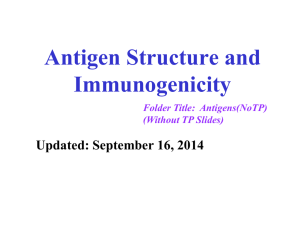Chapter 3
advertisement
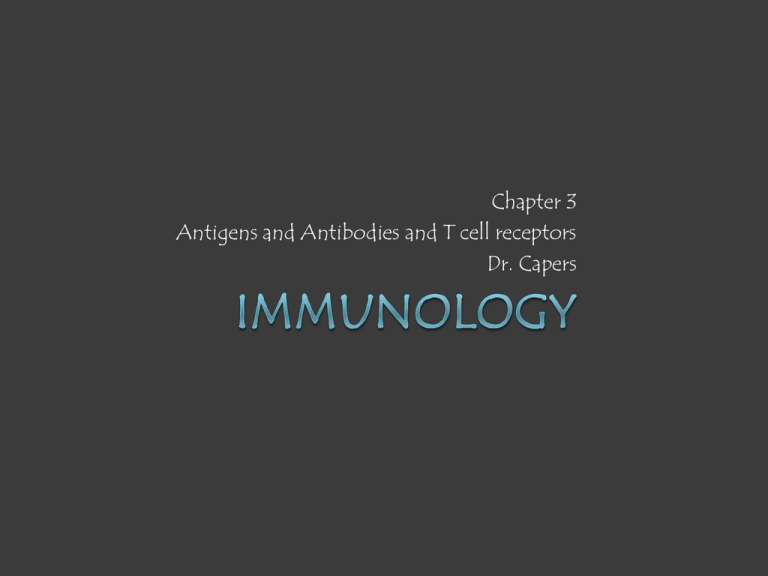
Chapter 3 Antigens and Antibodies and T cell receptors Dr. Capers Kindt • Goldsby • Osborne Kuby IMMUNOLOGY Sixth Edition Chapter 4 Antigens and Antibodies Copyright © 2007 by W. H. Freeman and Company Hallmark molecules of adaptive immunity Antibody and T-cell receptor Antibody is part of the B cell receptor Innate immunity recognizes patterns, whereas antibodies and T cell receptors have high degree of specificity Antibodies and T cell receptors ○ Recognize epitopes Immunologically active regions of immunogen that bind to antigen-specific antibodies or T-cell receptors Antibodies (Abs) Epitope binding proteins ○ Membrane bound on B cells OR ○ Secreted in blood - Humoral immunity Share structural features, bind to antigen, and participate in number of effector functions Known collectively as Immunoglobulins (Igs) Abs don’t kill anything, their job is to plant the “kiss of death” on an invader T cell Receptor T Cell Receptor ○ Expressed on surface of T cells ○ Recognize processed antigen complexed with MHC molecules Immunogenicity Ability to induce humoral and/or cell- mediated immune response Immunogen is substance that induces response Antigenicity Ability to combine specifically with Abs or T- cell receptor/MHC Not all antigens are immunogenic Haptens Haptens Hapten – too small, lack immunogenicity ○ If hapten is coupled to carrier protein, immune response can be induced ○ Hapten-carrier conjugate Produces 3 types of antigenic determinants - Antibodies to hapten - Antibodies to carrier - Antibodies to hapten-carrier conjugate Properties of Immunogen contribute to Immunogenicity 4 Properties ○ Foreignness ○ Molecular size ○ Chemical composition and complexity ○ Ability to be processed and presented on MHC Foreignness Lymphocytes that do not bind to self antigens are allowed to further develop Therefore they will later only recognized nonself antigens For example: ○ Bovine serum albumin (BSA) is not immunogenic when injected into cow but is when injected into chicken ○ Some macromolecules are highly conserved throughout evolution and display little immunogenicity - Cytochrome c, collagen Molecular Size ○ Active (good) immunogens - > 100,000 Daltons ○ Poor immunogens - < 5,000-10,000 Daltons Chemical Composition Polymers composed of multiple copies of same amino acid or sugar tend to be poor immunogens Lipids are haptens and need to be congugated with carrier to produce antibodies Important for assays for detection of some steroids, vitamins Susceptibility to antigen processing Large, insoluble macromolecules are more likely to be phagocytized for processing The biological system contributes to immunogenicity Host Genetic make-up Manner in which material is presented Use of agents (adjuvants) to enhance immunogenicity Genotype of recipient animal Genes of MHC Genes in coding for specific antibodies Material presentation – immunogen dosage and route of administration ○ Too low or high of dosage can induce tolerance ○ Single dose is often not enough – booster is needed ○ Route Intravenous (iv) Intradermal (id) Subcutaneous (sc) Intramuscular (im) Intraperitoneal (ip) - Antigen administered iv would travel to spleen; administered sc would travel to lymph nodes Adjuvants Enhance immunogenicity Not exactly sure how they work but are recognized by Toll-like receptors Water-in-oil adjuvants Freund’s incomplete adjuvant – antigen in aqueous solution, mineral oil, and emulsifying agent - Antigen is then released very slowly from injection site - Based on Freund’s complete adjuvant - also contained heat –killed Mycobacteria Epitopes Antigenic determinants recognized by B cells and T cells B cell epitopes tend to be on the outside of the antigen For example, the hydrophilic amino acids on a protein’s surface T cell epitopes from proteins derived from enzymatic digestion of peptide and then association with MHC Receptor-Ligand Interactions Antigen receptors of the adaptive immune system are transmembrane proteins ○ B cells – the B cell receptor ○ T cells – the T cell receptor Multiple noncovalent bonds ○ Hydrogen bonds ○ Ionic bonds ○ Van der Waals ○ Hydrophobic interactions Receptor-ligand interactions induce signal transduction pathways ○ Translated to biochemical change within affected cell ○ Ligand binding can - Induce conformational changes in receptor - Alter receptor location within membrane ○ Phosphorylation is an early step in signaling pathways - Phosphorylation of certain amino acids on enzymes can activate or deactivate them - Phosphorylation of tyrosine on some molecules is seen early, serine and threonine later ○ PIP2 in cell membrane phosphorylated to PIP3, serves as binding site for other proteins in membrane ○ PIP2 also hydrolyzed by other enzyme to IP3 and DAG - IP3 interacts with endoplasmic reticulum vesicles, release of stored calcium, altering activity of other proteins - For example – in lymphocytes, calcium ions bind calmodulin altering its conformation allowing dephosphorylation of NFAT (nuclear factor of Activated T cells) Immunoglobulin Superfamily All have similar structures Examples: ○ Antibodies ○ T-cell receptors ○ Class I and II MHC molecules ○ Part of B cell receptor Most members of immunoglobulin superfamily cannot bind antigen Antibodies and B cell Receptor B cell epitopes have characteristic properties Located on surface of immunogen – accessible to antibody When talking about proteins, the epitopes can be sequential or nonsequential (referring to amino acid sequence) depending on protein folding Basic Structure of Antibodies Known since late 19th century that antibodies are in serum ○ Serum is fluid phase that remains after plasma is allowed to clot ○ Antibodies are also found in other secretions Antibodies are heterodimers 2 light chains ○ ~ 22, 000 daltons each 2 heavy chains ○ ~ 55,000 daltons each First 110 aa of amino-terminal end of heavy and light chain vary depending on antibody specificity Different digestion procedures reveal different fragments F(ab’)2 still shows antigen binding capability Light Chains When aa sequences of light chains from several individuals were sequenced, pattern emerged: Amino-terminal end (110 aa) varied Other part remained constant Were found to be either kappa (κ) OR Lambda (λ) - In mice and humans, different lambda subtypes have been found Heavy Chains Amino-terminal end also shows variability 5 different heavy chain constant regions (isotypes) ○ IgM – μ ○ IgG – γ ○ IgA – α ○ IgD – δ ○ IgE – ε Some subisotypes have been discovered in some species Each antibody has 2 identical heavy chains, 2 identical light chains Overall structure of immunoglobulin Primary – sequence of amino acids Secondary – folding into series of β pleated sheets Tertiary – compact globular domains Quarternary – adjacent light and heavy chains interact Secondary Quartenary Structure Hypervariable regions = complimentaritydetermining regions (CDRs) ○ Complimentary to epitopes that they will bind Ab-antigen interaction Smaller antigens will fit in pockets in the variable regions of Abs Larger antigens will interact with flatter regions of the variable region 15-22 amino acid residues on antibody will interact with residues on antigen Hinge Region γ (gamma), δ (delta), and α (alpha) heavy chains have extended peptide sequence ○ Rich in proline and cysteine ○ Gives flexibility Immunoglobulins can be secreted or membranebound ○ Membrane-bound differ in the carboxyl-terminal end: - Extracellular “spacer” of 26 aa - Hydrophobic transmembrane sequence - Cytoplasmic tail B Cell Receptor (BCR) Heavy chain portion of membrane-bound antibody does not extend far enough through the cell membrane for signaling ○ Membrane bound antibody is accompanied by Igα and Igβ Antibody-mediated Effector Functions Remember, they plant “kiss of death” on an invader In addition to binding antigen, Abs can: ○ Promote phagocytosis (opsonization) ○ Activate complement ○ Antibody dependent cell mediated cytotoxicity (ADCC) Natural killer cells have receptor for Fc portion of antibody ○ Some can cross epithelial layers to be excreted through mucous or across placenta Monomeric IgM expressed on B cells Secreted is pentameric 1st class produced in primary response Activates complement Very good at agglutination Membrane bound on B cells Most abundant 4 human subclasses Crosses placenta Involved in complement Involved in allergic reactions Involvement in parasitic infections Predominant class in secretions J chain and secretory component helps with transport across intestinal wall J chain makes IgA more resistant to acids and enzymes found in digestive tract IgA and macrophages restrict commensal bacteria that occasionally enter the tissues from the intestines ○ Better for IgA to interact than IgG – this is because the Fc portion of IgG has high affinity for receptors of immune cells and would constantly trigger inflammatory responses Can cross-link large antigens ○ Exists as dimer Immunoglobulins when injected into another species can be immunogenic Isotypic – differences in constant region from one species to another Allotypic – differences (alleles) that occur in some individuals Idiotypic – differences in variable regions; will differ even on Abs of same isotype Monoclonal Antibodies Most antigens offer multiple epitopes However, a single B cell will only produce antibody specific to single epitope Antibodies found in serum are from many different B cells ○ Polyclonal antibodies However, for diagnostic uses, monoclonal antibodies are needed T cell receptor vs B cell receptor T cell receptor is only membrane bound ○ Doesn’t appear in soluble form like antibodies so more difficult to assess it’s structure Antigen binding of T cell receptor is weaker than that of antibodies Antigen recognized by T cells is not antigen alone but antigen associated with MHC molecules (a) T cell receptor (TCR) is specific for peptide A (b) Right MHC haplotype but wrong antigen (peptide B) (c) Right antigen (peptide A) but wrong haplotype T cell receptor (TCRs) ○ TCR heterodimers are similar to immunoglobulins Therefore they are classified in immunoglobulin superfamily Resembles Fab fragment TCRs ○ Associate with MHC – αβ TCR ○ Do not associate with MHC – γδ TCR - Much remains to be learned of function of γδ TCR TCR-CD3 Complex Accessory molecules help in signal transduction after interaction of T cell with antigen 2 Zeta ζζ chains Heterodimer of delta epsilon γε chains Heterodimer of delta epsilon εδ chains T cell accessory molecules T cells can be divided into 2 populations: ○ CD4+ Recognize antigen associated with Class II MHC OR ○ CD8+ Recognize antigen associated with Class I MHC ○ CD4 and CD8 function as coreceptors and assist with signal transduction Affinity of TCR for peptideMHC complexes is enhanced by coreceptors Allogenic – genetically different individuals of same species Alloreactivity of T cells is puzzling: ○ Evidence supports that T cells can only respond to antigen+MHC ○ However, T cells can recognize a foreign MHC molecule alone - As with transplants

